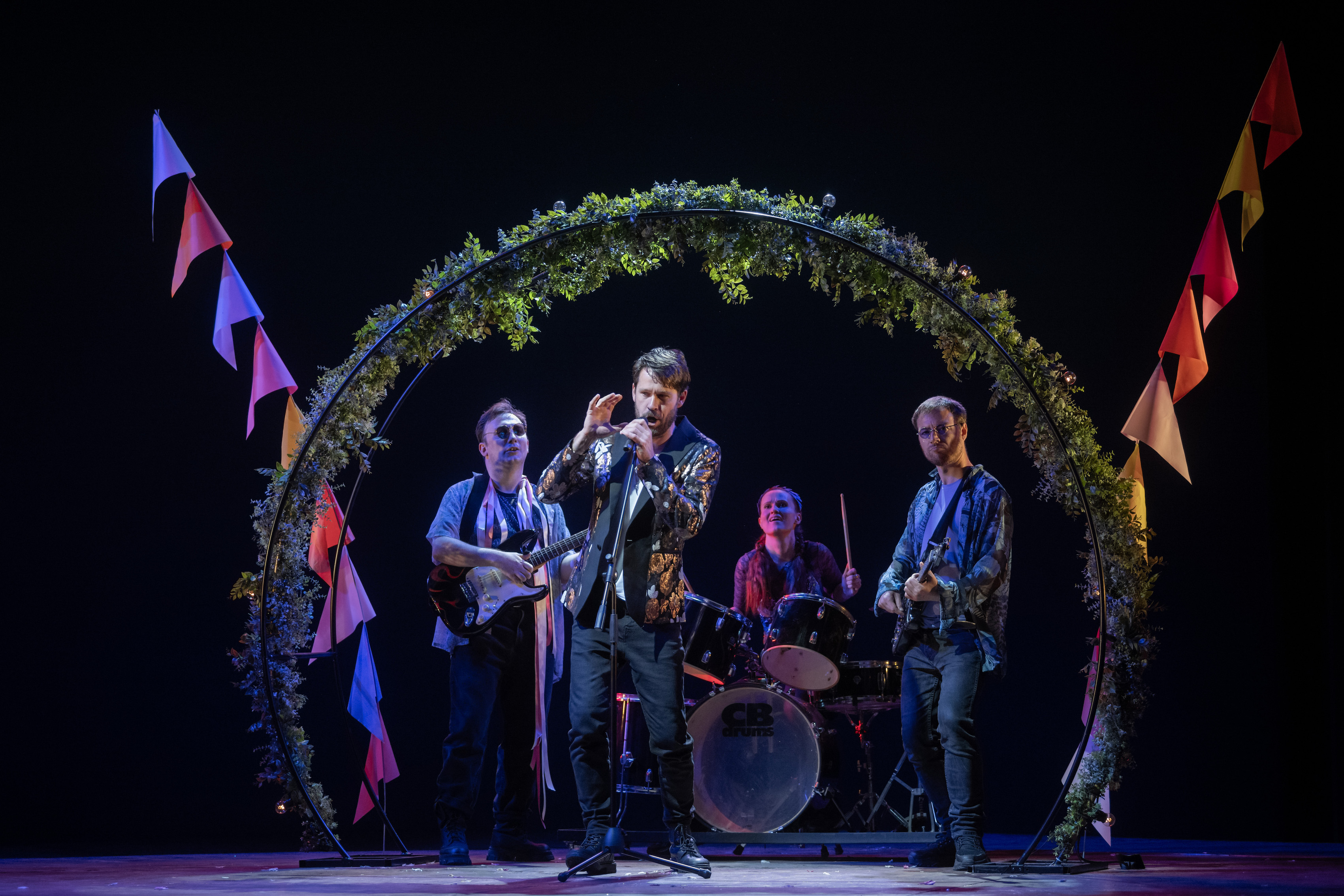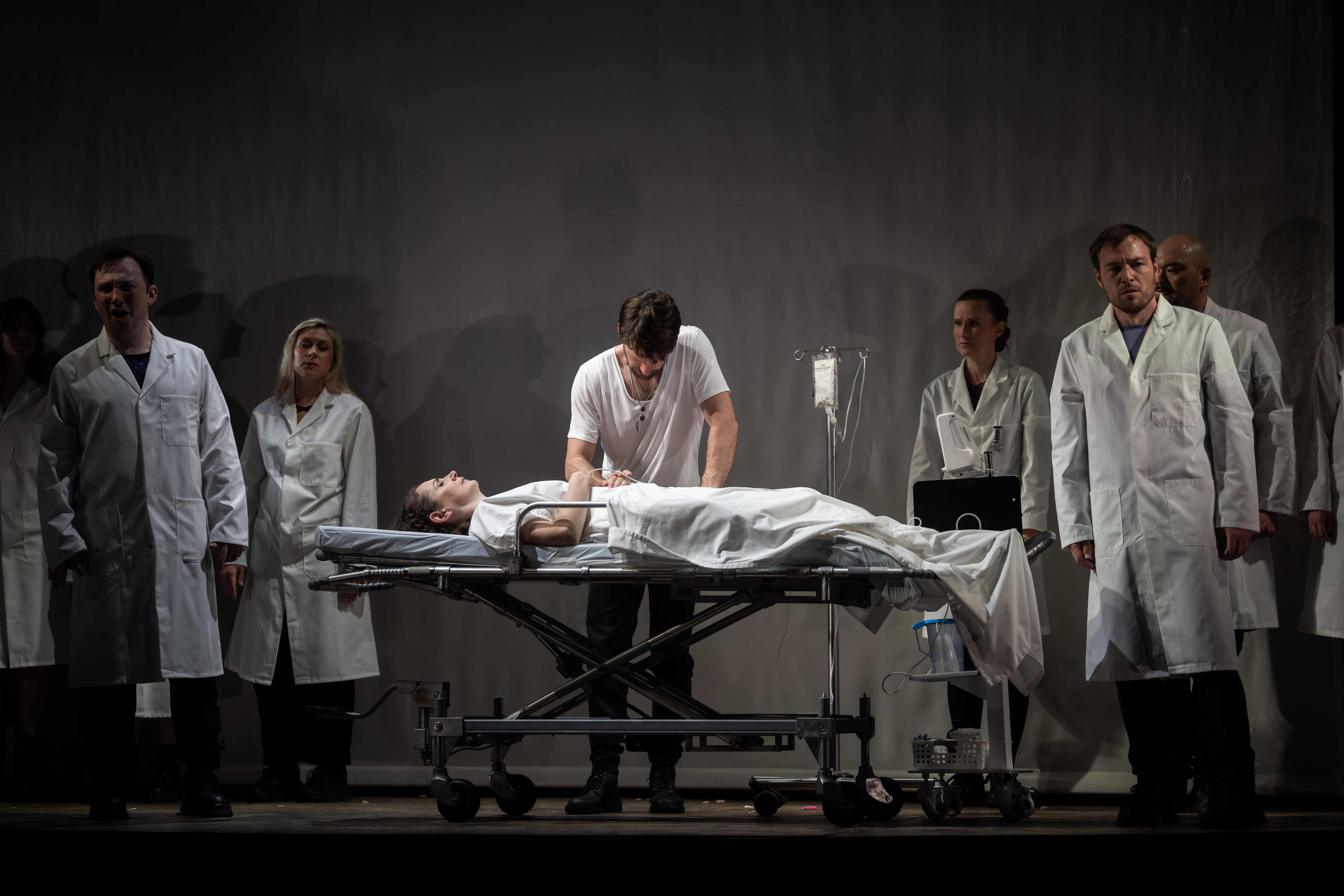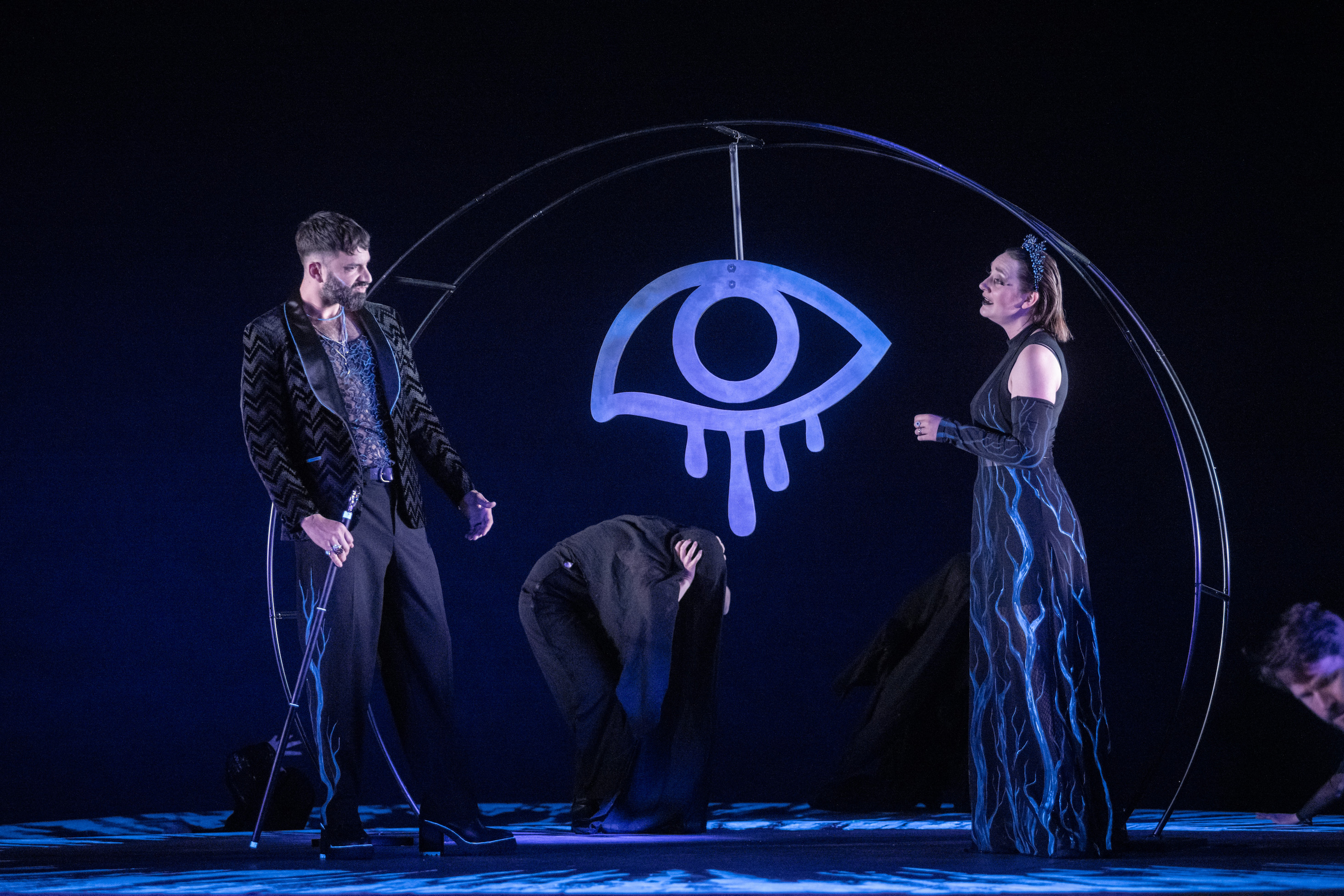L'Orfeo, Longborough Festival Opera review - landmark opera survives rock-star wedding and hospital soap | reviews, news & interviews
L'Orfeo, Longborough Festival Opera review - landmark opera survives rock-star wedding and hospital soap
L'Orfeo, Longborough Festival Opera review - landmark opera survives rock-star wedding and hospital soap
A strongly-sung descent into the underworld overcomes hit-and-miss stagecraft

Cotswold Line railway stations currently sport posters for Alex James’s “Big Feastival”, in which the ex-Blur bassist hosts a food-and-music jamboree on his cheese-making farm. Just up the road at Longborough Festival Opera, the crowd gathered on stage for the nuptials of Orfeo and Euridice would fit snugly in chez James as well.
For Olivia Fuchs’s new production of Monteverdi’s L’Orfeo, an arch wreathed in laurels presides over a chilled-out parade of casual summer wear, with glam accessories, as the rock-god singer finally gets to wed his beloved. An atmosphere of B-list villeggiatura, more Muddy Stilettos than Country Life, sets the tone for the sort of wedding that might have David Cameron top of the guest list.
With its slightly naff bucolic glitz, and (unplayed) drum kits and electric guitars, the opening look for Longborough’s take on Monteverdi’s revolutionary “favola in musica” of 1607 may irritate as much as its sound delights. Nate Gibson’s stage design, its spiral ramp coiling up towards a circular platform, helps to conjure not a divine dreamworld so much as a bourgeois festival frolic: Renaissance pastoral, after all, routinely took the form of elite fantasies about the simple life. After the cast assembles, Caroline Taylor’s La Musica welcomes us to a celebration of music and love that, from ring dances to wedding cake, oozes showbiz self-regard more than godlike artistry. That’s the point, of course. Monteverdi’s trail-blazing music-drama will soon lead down to a far darker place. For now, Peter Gijsbertsen’s low-lying tenor, in numbers such as “Rosa del ciel”, endows Orfeo with a crooner’s shallow charisma, not genuine lyric heft. If this Orfeo’s role as a cheesy glam-rock frontman (pictured above) somewhat blunts the edge of his heaven-sent ardour, it also leaves Gijsbertsen with plenty to prove. Rosie Lomas’s Ninfa tenderly lauds the happy couple as the cake is cut and toasts drunk, to robust choral hosannas from the 12-strong cast. In the pit, Robert Howarth directs Baroque specialists La Serenissima. Their flavoursome and fine-boned period-instrument playing – from the opening fanfares onwards – initially feels a little at odds with the generic modern-dress merry-making above.
That’s the point, of course. Monteverdi’s trail-blazing music-drama will soon lead down to a far darker place. For now, Peter Gijsbertsen’s low-lying tenor, in numbers such as “Rosa del ciel”, endows Orfeo with a crooner’s shallow charisma, not genuine lyric heft. If this Orfeo’s role as a cheesy glam-rock frontman (pictured above) somewhat blunts the edge of his heaven-sent ardour, it also leaves Gijsbertsen with plenty to prove. Rosie Lomas’s Ninfa tenderly lauds the happy couple as the cake is cut and toasts drunk, to robust choral hosannas from the 12-strong cast. In the pit, Robert Howarth directs Baroque specialists La Serenissima. Their flavoursome and fine-boned period-instrument playing – from the opening fanfares onwards – initially feels a little at odds with the generic modern-dress merry-making above.
Come the Messenger, Sylvia, and everything changes. Frances Gregory (later to return as Proserpina) proves outstanding as the party-pooper who flips joy to grief, her rich mezzo aceing the tricky narrative of “In un fiorito prato”. The fatal snake-bite that slays Euridice may plunge the star singer from ecstasy to agony, but frees Gijsbertsen to show infinitely richer vocal colours. He caught the moaning, faltering fragility of Orfeo’s despair as a downpour aptly, and ominously, drummed on the Longborough roof. From now on, Gijsbertsen commanded a vein of rueful, tragic intensity, as if Chris de Burgh had morphed into Leonard Cohen.  Now Fuchs springs her own directorial trap. The broken feast gives way to the hospital corridors where Euridice lies on a gurney flanked by staff in scrubs under pitiless white light (pictured above). If this conceit aims to channel our Covid-era dreads of sudden bereavement, all memories of medical soap-operas prove sadly impossible to banish. Meanwhile, the instrumental textures of La Serenissima powerfully darken. Monteverdi’s spine-tingling evocations of the lower realms are driven by splendidly shady cornetts and sackbuts.
Now Fuchs springs her own directorial trap. The broken feast gives way to the hospital corridors where Euridice lies on a gurney flanked by staff in scrubs under pitiless white light (pictured above). If this conceit aims to channel our Covid-era dreads of sudden bereavement, all memories of medical soap-operas prove sadly impossible to banish. Meanwhile, the instrumental textures of La Serenissima powerfully darken. Monteverdi’s spine-tingling evocations of the lower realms are driven by splendidly shady cornetts and sackbuts.
Hope, however, still flickers. With “Ecco l’altra palude”, Siân Cameron’s mezzo lends a warm authority to Orfeo’s guide towards Hades, La Speranza. When not cleaning medical kit on the wards, Freddie Tong’s formidable, granitic bass-baritone Caronte serves as impressive gate-keeper to the underworld. Orfeo’s plea to Caronte to cross the border from the land of the living emerged, as often, as the emotional pinnacle of the entire piece. In “Possente spirto” and later exchanges with Tong, Gijsbertsen invests the heartbroken roulades of a super-demanding vocal part with emotional authenticity as well as technical virtuosity. It's all a far cry from his glib balladeer at the opera’s outset. La Serenissima enrich the sumptuous gloom with fine string ritornellos – plus plangent commentary from Lynda Sayce’s theorbo, and Oliver Wass’s harp. But does Orfeo really need to chloroform Caronte? A little too much Casualty, maybe.  After the black-clad conga line of the infernal spirits, and the interval, the Underworld – bathed in the dramatic shades of Tim Mitchell’s lighting design – turned out to mimic the wedding above. We descend from genteel party marquee to Goth-tinged basement nightclub. Gregory’s sensitive, persuasive Proserpina and Julien Ségol’s resonant, if tetchy, Plutone spar over Orfeo’s fate, as a Picasso-like weeping-eye motif oversees events (pictured above). The distraught singer’s lonely quest among the shades sees Gijsbertsen double down on soulfulness, while the pair’s reunion allows Aoife Miskelly’s affecting and assured Euridice her all-too-brief spell in the Stygian limelight. But it’s Orfeo whose sorrow will steal the show after he fatally looks back. So Hades reclaims his spouse, and in “Questi i campi di Tracia”, Gijsbertsen delivers a nuanced monologue of misery that makes the melismatic span and swoop of Monteverdi’s writing lucid and credible. After this full-spectrum suffering, the deus ex machina intervention of Seumas Begg’s radiant-voiced Apollo can only come as an anticlimax – true in all versions, not just this one. The couple's apotheosis feels like a downbeat conclusion, its tone stunned and subdued.
After the black-clad conga line of the infernal spirits, and the interval, the Underworld – bathed in the dramatic shades of Tim Mitchell’s lighting design – turned out to mimic the wedding above. We descend from genteel party marquee to Goth-tinged basement nightclub. Gregory’s sensitive, persuasive Proserpina and Julien Ségol’s resonant, if tetchy, Plutone spar over Orfeo’s fate, as a Picasso-like weeping-eye motif oversees events (pictured above). The distraught singer’s lonely quest among the shades sees Gijsbertsen double down on soulfulness, while the pair’s reunion allows Aoife Miskelly’s affecting and assured Euridice her all-too-brief spell in the Stygian limelight. But it’s Orfeo whose sorrow will steal the show after he fatally looks back. So Hades reclaims his spouse, and in “Questi i campi di Tracia”, Gijsbertsen delivers a nuanced monologue of misery that makes the melismatic span and swoop of Monteverdi’s writing lucid and credible. After this full-spectrum suffering, the deus ex machina intervention of Seumas Begg’s radiant-voiced Apollo can only come as an anticlimax – true in all versions, not just this one. The couple's apotheosis feels like a downbeat conclusion, its tone stunned and subdued.
The jubilant moresca dance that closes L’Orfeo may survive from the earlier, harsher finale preserved in one libretto. That would make sense. In any case, here it showcases Howarth’s always zestful and alert rhythmic drive, along with the unobtrusively fluent movement direction by Clare Whistler. Dance and song alone unite this world with the one below, in overlapping rings of love and loss.
The future of Arts Journalism
You can stop theartsdesk.com closing!
We urgently need financing to survive. Our fundraising drive has thus far raised £49,000 but we need to reach £100,000 or we will be forced to close. Please contribute here: https://gofund.me/c3f6033d
And if you can forward this information to anyone who might assist, we’d be grateful.

Subscribe to theartsdesk.com
Thank you for continuing to read our work on theartsdesk.com. For unlimited access to every article in its entirety, including our archive of more than 15,000 pieces, we're asking for £5 per month or £40 per year. We feel it's a very good deal, and hope you do too.
To take a subscription now simply click here.
And if you're looking for that extra gift for a friend or family member, why not treat them to a theartsdesk.com gift subscription?
more Opera
 Tosca, Welsh National Opera review - a great company reduced to brilliance
The old warhorse made special by the basics
Tosca, Welsh National Opera review - a great company reduced to brilliance
The old warhorse made special by the basics
 BBC Proms: The Marriage of Figaro, Glyndebourne Festival review - merriment and menace
Strong Proms transfer for a robust and affecting show
BBC Proms: The Marriage of Figaro, Glyndebourne Festival review - merriment and menace
Strong Proms transfer for a robust and affecting show
 BBC Proms: Suor Angelica, LSO, Pappano review - earthly passion, heavenly grief
A Sister to remember blesses Puccini's convent tragedy
BBC Proms: Suor Angelica, LSO, Pappano review - earthly passion, heavenly grief
A Sister to remember blesses Puccini's convent tragedy
 Orpheus and Eurydice, Opera Queensland/SCO, Edinburgh International Festival 2025 review - dazzling, but distracting
Eye-popping acrobatics don’t always assist in Gluck’s quest for operatic truth
Orpheus and Eurydice, Opera Queensland/SCO, Edinburgh International Festival 2025 review - dazzling, but distracting
Eye-popping acrobatics don’t always assist in Gluck’s quest for operatic truth
 MARS, Irish National Opera review - silly space oddity with fun stretches
Cast, orchestra and production give Jennifer Walshe’s bold collage their all
MARS, Irish National Opera review - silly space oddity with fun stretches
Cast, orchestra and production give Jennifer Walshe’s bold collage their all
 Káťa Kabanová, Glyndebourne review - emotional concentration in a salle modulable
Janáček superbly done through or in spite of the symbolism
Káťa Kabanová, Glyndebourne review - emotional concentration in a salle modulable
Janáček superbly done through or in spite of the symbolism
 Buxton International Festival 2025 review - a lavish offering of smaller-scale work
Allison Cook stands out in a fascinating integrated double bill of Bernstein and Poulenc
Buxton International Festival 2025 review - a lavish offering of smaller-scale work
Allison Cook stands out in a fascinating integrated double bill of Bernstein and Poulenc
 Tosca, Clonter Opera review - beauty and integrity in miniature
Happy surprises and a convincing interpretation of Puccini for today
Tosca, Clonter Opera review - beauty and integrity in miniature
Happy surprises and a convincing interpretation of Puccini for today
 Hamlet, Buxton International Festival review - how to re-imagine re-imagined Shakespeare
Music comes first in very 19th century, very Romantic, very French operatic creation
Hamlet, Buxton International Festival review - how to re-imagine re-imagined Shakespeare
Music comes first in very 19th century, very Romantic, very French operatic creation
 Falstaff, Glyndebourne review - knockabout and nostalgia in postwar Windsor
A fat knight to remember, and snappy stagecraft, overcome some tedious waits
Falstaff, Glyndebourne review - knockabout and nostalgia in postwar Windsor
A fat knight to remember, and snappy stagecraft, overcome some tedious waits
 Salome, LSO, Pappano, Barbican review - a partnership in a million
Asmik Grigorian is vocal perfection in league with a great conductor and orchestra
Salome, LSO, Pappano, Barbican review - a partnership in a million
Asmik Grigorian is vocal perfection in league with a great conductor and orchestra
 Semele, Royal Opera review - unholy smoke
Style comes and goes in a justifiably dark treatment of Handelian myth
Semele, Royal Opera review - unholy smoke
Style comes and goes in a justifiably dark treatment of Handelian myth

Add comment